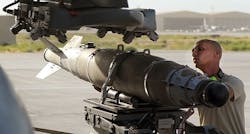Growing demand prompts Air Force to nearly double Boeing JDAM smart munitions contract
Officials of the Air Force Life Cycle Management Center at Hill Air Force Base, Utah, added $1.5 billion to a contract first awarded in 2014 to the Boeing Defense, Space & Security segment in St. Louis for JDAM tailkits.
JDAM describes a guidance kit that converts unguided bombs into all-weather precision-guided munitions. JDAM tailkits add an integrated inertial guidance system coupled to a Global Positioning System (GPS) receiver to give bombs a published range of as far as 15 nautical miles.
JDAM-equipped bombs range from 500 to 2,000 pounds by adding a tail section with aerodynamic control surfaces, a body kit, and a combined inertial guidance system and GPS guidance control unit.
The Air Force nearly doubled the value of the Boeing JDAM contract due to warfighter demand and to replenish depleted inventories. The Air Force on Monday increased the value of Boeing's JDAM tailkit contract from $1.7 billion to $3.2 billion.
In addition to GPS and inertial guidance, some JDAM-equipped munitions also use laser guidance. The performance of laser-guided smart munitions sometimes can be hindered by bad weather, smoke, dust, and other obscurants.
Laser-guidance kits sometimes are added to the nose of JDAM-equipped bombs for precision terminal guidance.
Military aircraft that can carry JDAM include the B-1B supersonic bomber; the B-2A stealth bomber; B-52H bomber; F-15E fighter-bomber; F-16C jet fighter, the F/A-18 fighter-bomber; F-22 fighter; F-35 joint strike fighter; A-4 light-attack bomber; AV-8B jump jet; A-10 close air support jet; A-29 Super Tucano; Mitsubishi F-2; Panavia Tornado; Mirage F-1; and Saab JAS 39 Gripen. The MQ-9 Reaper unmanned aerial vehicle (UAV) also can carry the JDAM.
On this contract modification Boeing will do the work in St. Louis and should be finished by September 2020. For more information contact Boeing Defense, Space & Security online at www.boeing.com/defense, or the Air Force Life Cycle Management Center at www.wpafb.af.mil/aflcmc.
About the Author
John Keller
Editor-in-Chief
John Keller is the Editor-in-Chief, Military & Aerospace Electronics Magazine--provides extensive coverage and analysis of enabling electronics and optoelectronic technologies in military, space and commercial aviation applications. John has been a member of the Military & Aerospace Electronics staff since 1989 and chief editor since 1995.
